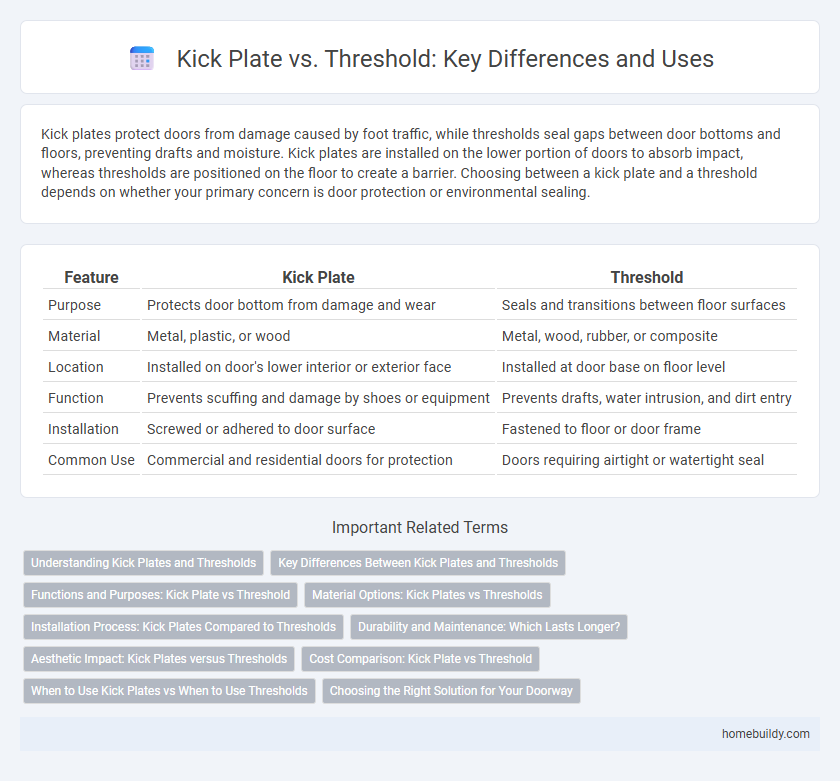Kick plates protect doors from damage caused by foot traffic, while thresholds seal gaps between door bottoms and floors, preventing drafts and moisture. Kick plates are installed on the lower portion of doors to absorb impact, whereas thresholds are positioned on the floor to create a barrier. Choosing between a kick plate and a threshold depends on whether your primary concern is door protection or environmental sealing.
Table of Comparison
| Feature | Kick Plate | Threshold |
|---|---|---|
| Purpose | Protects door bottom from damage and wear | Seals and transitions between floor surfaces |
| Material | Metal, plastic, or wood | Metal, wood, rubber, or composite |
| Location | Installed on door's lower interior or exterior face | Installed at door base on floor level |
| Function | Prevents scuffing and damage by shoes or equipment | Prevents drafts, water intrusion, and dirt entry |
| Installation | Screwed or adhered to door surface | Fastened to floor or door frame |
| Common Use | Commercial and residential doors for protection | Doors requiring airtight or watertight seal |
Understanding Kick Plates and Thresholds
Kick plates and thresholds both protect high-traffic areas in buildings but serve different functions; kick plates shield doors from scuffs and damage caused by foot traffic, while thresholds provide a transition between different floor surfaces and seal gaps under doors. Made from durable materials like stainless steel or aluminum, kick plates are installed on the lower portion of doors to extend their lifespan. Thresholds also contribute to energy efficiency by preventing drafts and moisture infiltration, enhancing the overall durability of entrances.
Key Differences Between Kick Plates and Thresholds
Kick plates are protective metal or plastic panels installed on the lower part of doors to prevent damage from foot traffic, whereas thresholds are horizontal components that bridge the gap between different floor levels or rooms, often providing a seal against drafts and moisture. Kick plates primarily enhance door durability and aesthetics, while thresholds improve energy efficiency, accessibility, and barrier protection. Both serve distinct functional roles in building entryways, with kick plates focusing on impact resistance and thresholds on structural transition and environmental control.
Functions and Purposes: Kick Plate vs Threshold
Kick plates protect doors from damage caused by foot traffic, impacts, and equipment, enhancing durability in high-traffic areas. Thresholds provide a sealed transition between different floor surfaces, improving insulation, moisture control, and preventing drafts. While kick plates focus on door protection, thresholds concentrate on environmental control and accessibility at entryways.
Material Options: Kick Plates vs Thresholds
Kick plates are typically made from durable metals like stainless steel, aluminum, and brass, providing strong protection against door damage and wear. Thresholds commonly use materials such as aluminum, wood, and vinyl, designed to create a seal and smooth transition between flooring surfaces. While kick plates prioritize impact resistance, threshold materials emphasize durability against moisture and temperature changes.
Installation Process: Kick Plates Compared to Thresholds
Kick plates are typically installed by attaching a metal or plastic plate to the lower portion of a door, requiring minimal tools and effort, often just screws or adhesive. Thresholds involve fitting a raised strip at the base of the doorway, which may require precise measurements, cutting, and securing to the floor, making installation more complex and time-consuming. The simplicity of kick plate installation makes it a preferred choice for quick door protection upgrades without modifying the doorway structure.
Durability and Maintenance: Which Lasts Longer?
Kick plates, typically made from durable materials like stainless steel or aluminum, are designed to protect doors from frequent impacts and resist scratches, extending the door's lifespan with minimal maintenance. Thresholds, usually installed at the base of doorways to seal gaps, experience wear from foot traffic and environmental exposure, often requiring more frequent replacement or upkeep. The kick plate generally lasts longer due to its material robustness and lower exposure to abrasive elements compared to thresholds.
Aesthetic Impact: Kick Plates versus Thresholds
Kick plates enhance the aesthetic appeal of doors by providing a sleek, polished look that complements various interior designs, whereas thresholds often appear utilitarian and can disrupt visual continuity. The metallic or decorative finishes of kick plates add elegance and protect against scuffs, while thresholds primarily serve functional purposes like weatherproofing and transition between flooring materials. Choosing a kick plate over a threshold can elevate the door's overall design without compromising durability.
Cost Comparison: Kick Plate vs Threshold
Kick plates generally cost between $15 and $60 depending on material and size, while thresholds range from $20 to $100 based on durability and design. Kick plates made of stainless steel or aluminum offer affordable protection against door damage, whereas thresholds provide weatherproofing benefits but at a potentially higher initial investment. Choosing between the two depends on balancing budget constraints with functional needs such as door impact resistance or sealing efficiency.
When to Use Kick Plates vs When to Use Thresholds
Kick plates are ideal for protecting the lower portion of doors from damage caused by foot traffic, making them suitable for high-traffic entrances in commercial and residential settings. Thresholds are best used to seal the gap between the door and the floor, providing insulation, weatherproofing, and accessibility benefits. Choose kick plates when door protection is the priority, and opt for thresholds when energy efficiency and barrier sealing are needed.
Choosing the Right Solution for Your Doorway
Kick plates provide durable protection for the lower section of doors, preventing damage from foot traffic and equipment, while thresholds create a seal that improves insulation and accessibility by bridging gaps between doorway surfaces. When choosing the right solution, consider factors such as the level of wear and tear, weatherproofing needs, and compliance with accessibility standards like ADA. Selecting between a kick plate and a threshold hinges on whether your priority is safeguarding door integrity or enhancing energy efficiency and entryway functionality.
Kick plate vs Threshold Infographic

 homebuildy.com
homebuildy.com